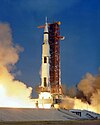This article needs additional citations for
verification. (May 2023) |
 | |
| Function | Uncrewed launch vehicle |
|---|---|
| Manufacturer | Von Braun |
| Country of origin | United States |
| Size | |
| Height | 49.62 m (162.29 ft) |
| Diameter | 6.52 m (21.39 ft) |
| Mass | 524,484 kg |
| Stages | 3 (all used on various vehicles, now retired) |
| Launch history | |
| Status | Never flown |
| Launch sites | N/A |
| First stage - S-I | |
| Engines | 8 H-1 |
| Thrust | 7,582 kN |
| Burn time | 150 seconds |
| Propellant | RP-1/ LOX |
| Second stage Titan I | |
| Engines | 2 LR-87-3 |
| Thrust | 1,467 kN |
| Burn time | 138 seconds |
| Propellant | RP-1/LOX |
| Third stage - Centaur C | |
| Engines | 2 RL-10A-1 |
| Thrust | 133 kN |
| Burn time | 430 seconds |
| Propellant | LH2 / LOX |
Saturn A-1, studied in 1959, was projected to be the first version of Saturn I and was to be used if necessary before the S-IV liquid hydrogen second stage became available. The first stage, proposed for the Juno V rocket, but finally used for the first Saturn rocket, would propel the Saturn A-1 into space, with the first stage of a Titan I [1]: 3–6 missile continuing the flight and finally, a Centaur [1]: 3–6 C high-energy double-engine third stage could perform a small burn to send a payload into its final orbit, or it can perform a big burn to take a payload out of Earth orbit to other planets. This rocket never flew, but all stages of the Saturn A-1 were used on different launch vehicles. Today, they are all retired.
References
- ^ a b Lunar Exploration with Saturn-Boosted Systems (PDF) (Technical report). Army Ballistic Missile Agency. October 1, 1959. Archived (PDF) from the original on May 31, 2023. Retrieved May 31, 2023.
